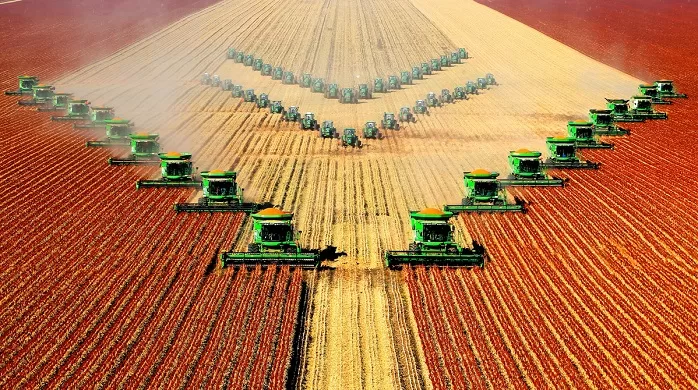
Beijing to strengthen food security to satisfy domestic demand and withstand potential US maritime blockade.
RIA Novosti news agency (RT ) reports that in a bid to secure a domestic food supply and cut down reliance on foreign imports, China is expanding its farmlands. As explained by the newspaper the China Daily, “the rapidly ageing rural population has made it more challenging for China to ensure food security,” bringing about a decline in the number of farmers and forcing the country to depend more on imported produce.
According to China Daily by the end of 2021, the population aged 60 or above reached 267 million, or 18.9 percent of the total population, while those aged above 65 reached 200 million, or 14.2 percent. Although China’s arable land ranks third in the world behind the United States and India, if divided by its huge population of more than 1.41 billion, each Chinese person has an average arable land of only about 0.1 hectare. A typical rural family farm is only 0.3-0.5 hectare and earning are low. Many young and middle-aged farmers have left their villages in search of non-farming but better-paying jobs in cities, and efforts to lure young farmers back to their villages have mostly been in vain.
In China, arable land is collectively owned and allocated to rural households in accordance with the number of their family members. So farmers can only transfer their land right use, not the ownership. By transferring their land right use to investors, farmers can earn not only transfer fees but also year-end profits while getting wages for the work they do in cities or, more importantly, working on these huge farms and getting paid for it.
China has less than 10 percent of the world’s arable land but feeds one fifth of world’s people
FAO

To make farming more profitable, the government has been encouraging farmers who prefer working in cities to transfer their land use rights to investors, who, with larger plots to work on, can use machines and new technologies to reduce production cost and increase output.
As a result, intensive farming is emerging in China with some new farms being as big as 200 hectares. With the help of new equipment and technologies, fewer people are needed to cultivate the land and harvest crops, and the larger farms are more economically viable.
China Daily reports that this new way of farming seems attractive to young people, many of whom are returning to their home villages to operate tractors, use harvesters and even drones for cultivation. Over the past few years more young people with higher education are taking up modern farming to earn decent incomes.
With modern farming becoming more profitable, rural working and living conditions are fast improving, prompting more young people to choose farming as a career. Also, modern farming has been creating new employment opportunities in villages in some areas.
This has helped boost domestic tourism with travelers opting for home-stays in villages. In addition, the development of e-commerce is prompting many young people to return to their villages to operate such home-stays or engage in other profitable employment.
China Daily comments that the number of young people returning to villages is still relatively small but is an encouraging sign to help narrow the urban-rural income gap and make agriculture attractive again for the young.

Agricultural machines harvest sorghum at Nenjiang Farm, Heilongjiang province, in October 2019. [Photo provided to China Daily]
However, as the RIA Novosti article points out, there is an additional geopolitical element to China’s push for more farming. The terminology of “food security” indicates that Beijing is well aware its growing reliance on foreign food imports represents a critical strategic risk for the country, one which can be leveraged by a hostile United States in a maritime embargo. RIA Novosti suggests that in this context Beijing is conscious of need to significantly “reduce its dependency on food imports, a great deal of which happen to come from the US itself.”
The RIA Novosti goes on to say:
One strategic contingency by China to address these war plans has been to build the Belt and Road initiative and therefore establish multiple logistical routes across Eurasia, making it less strategically vulnerable to maritime power. But that isn’t enough. The sheer size of China’s population and, subsequently, food demand, means Beijing has minimal room to compromise on this, and its reliance on products grown en masse in America, such as soybeans, is a massive liability. This is why not only has China pushed the BRI, but it is pushing a doctrine of self-reliance on all fronts, which Xi Jinping has described as “dual circulation.” That also includes not only things like microchip production, but farming and food as well.
China’s new economic outlook is a response to the reality that even without considering actual war by the US, the era of globalization is ending and the US is forcibly tearing it up, with everything becoming strategized. Therefore, China’s bid to shore up its own farming has both a military and strategic dynamic.
See also: The ‘Malacca Dilemma’ and China’s energy security. https://china-environment-net.com/wp/2023/08/14/chinas-energy-security-and-the-malacca-dilemma/
Sources:
- China Daily, 2023-08-15. https://www.chinadaily.com.cn/a/202308/15/WS64daaba5a31035260b81c130.html
- RT – RIA Novosti, 2023-08-15. https://www.rt.com/news/581525-china-farming-war-blockade/